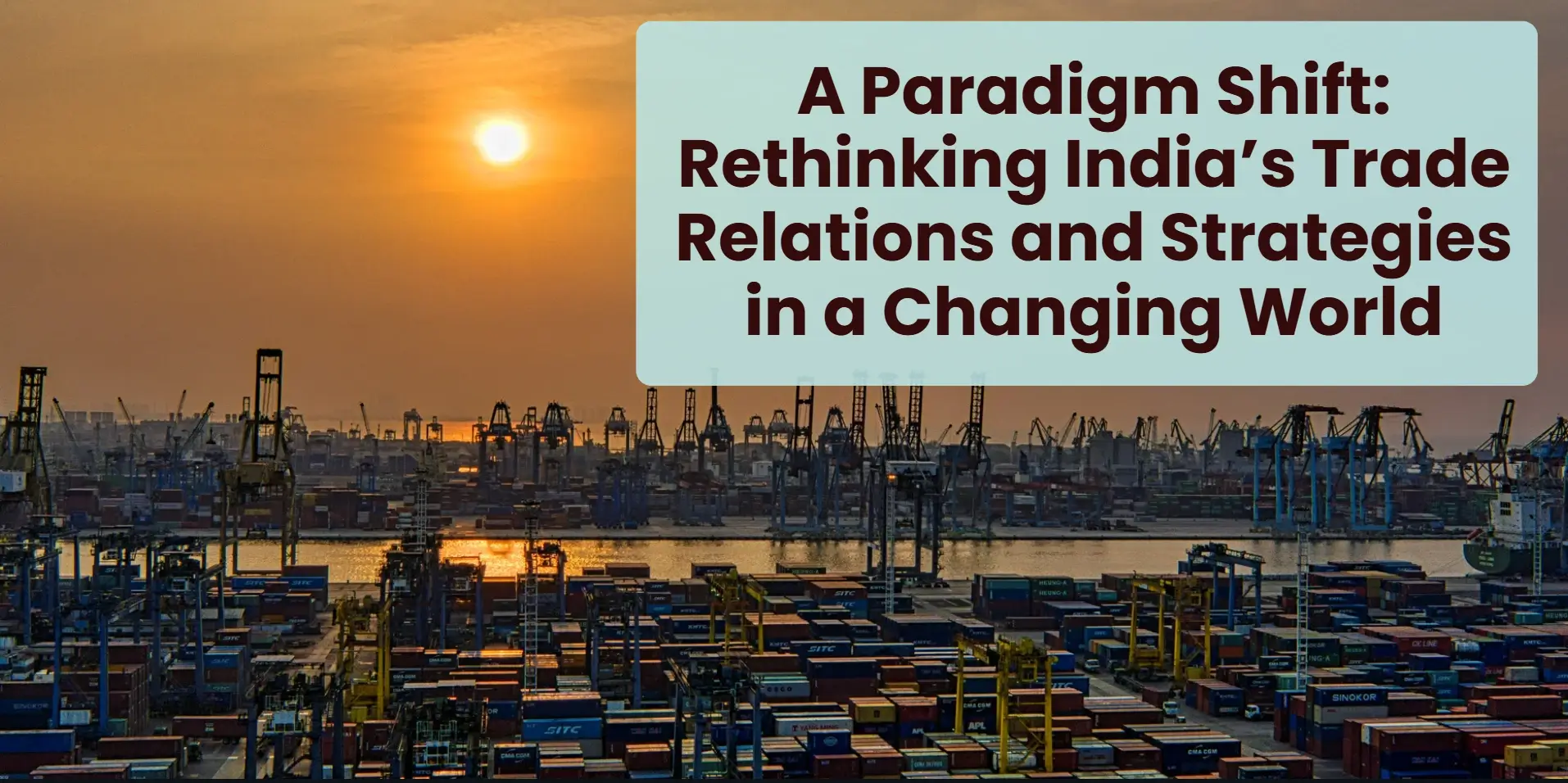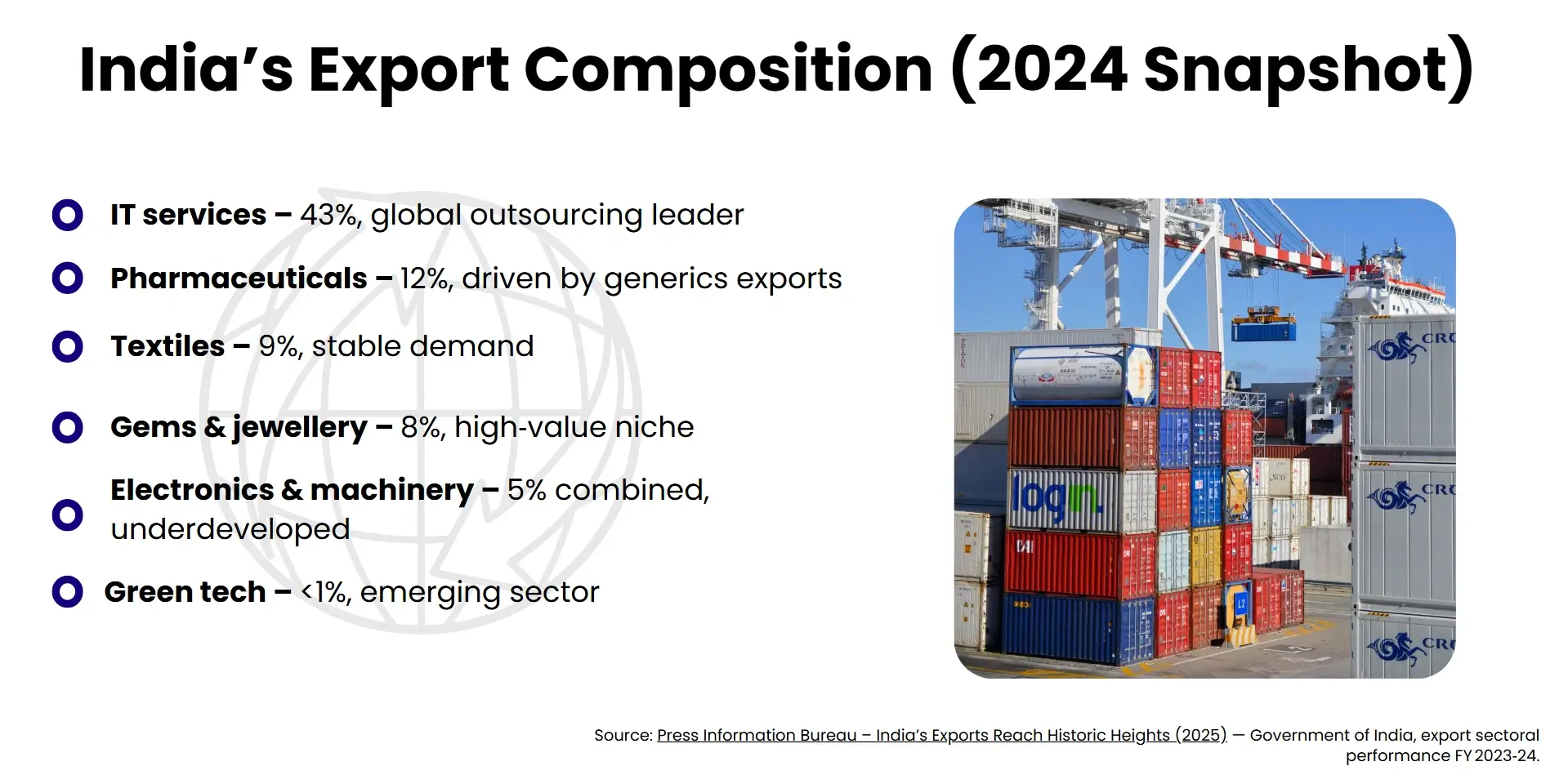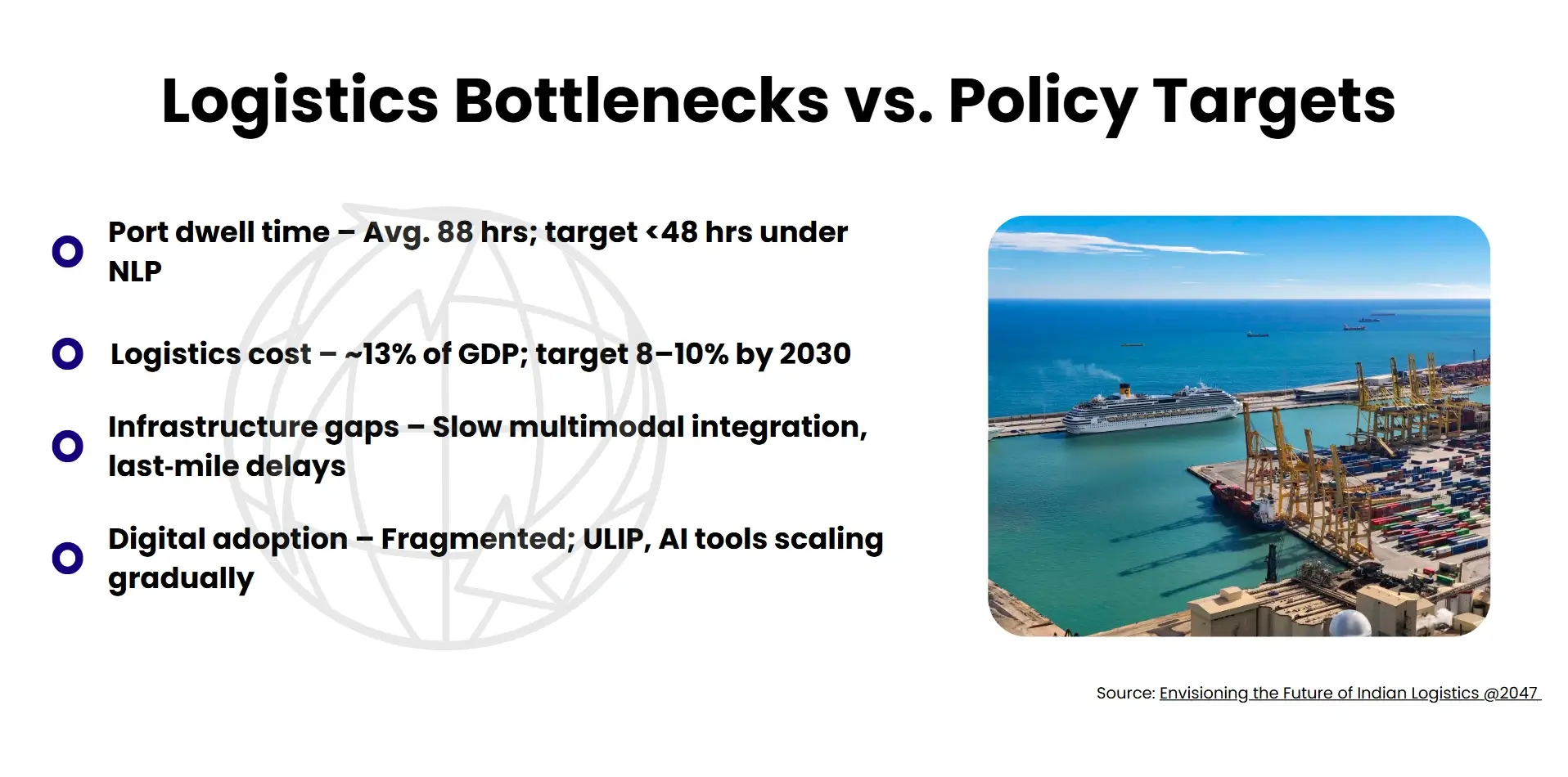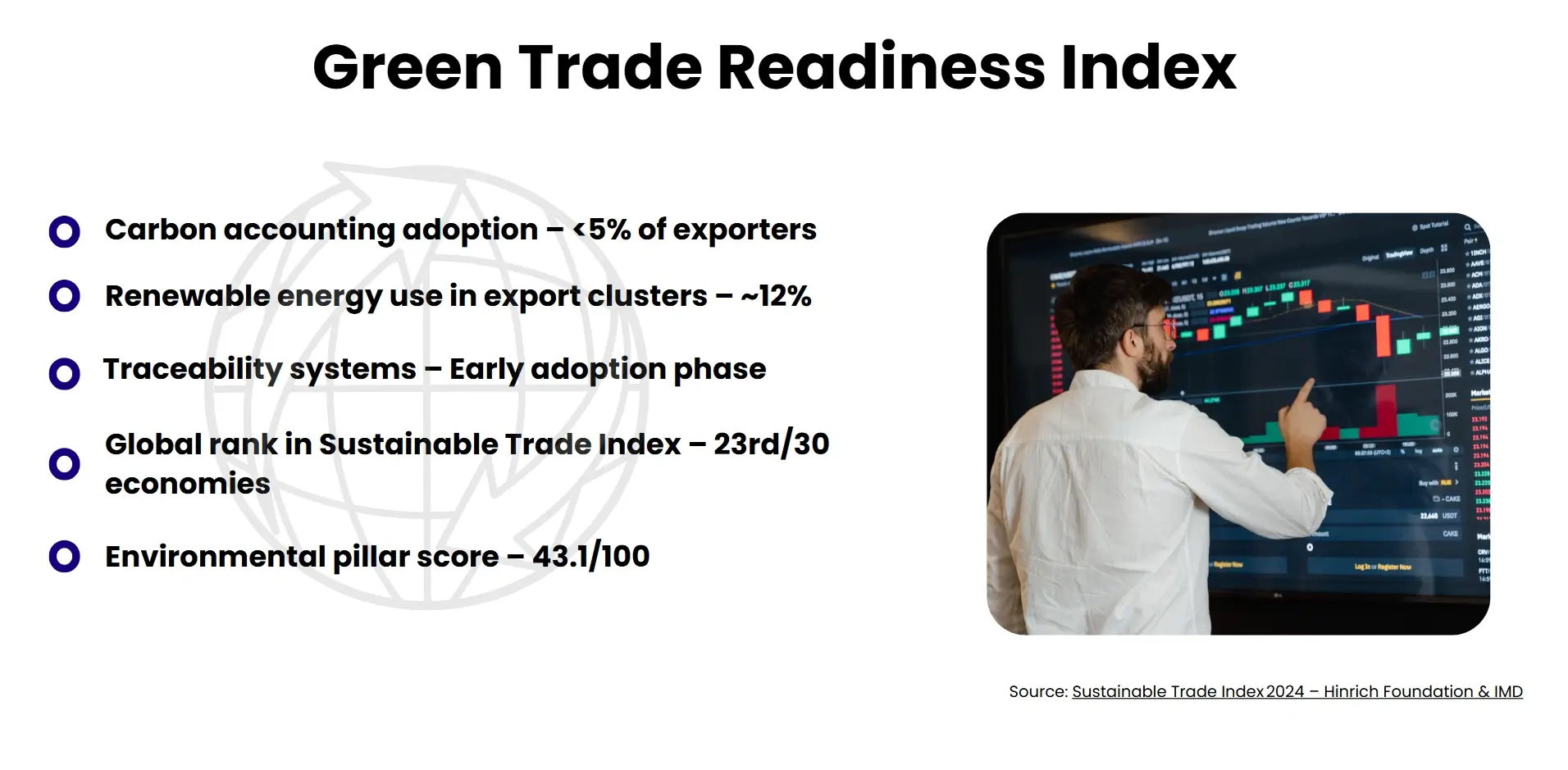It postulates that India needs to reconsider the trade policies, such as diversification of products, improved infrastructure, and adoption of sustainability, to negotiate the changing world economy and consolidate strategic dealings.

India is at the crossroads of its economic development story, having to navigate not only the crosswinds of uncertainty in the global economy but also the winds of change in the face of trade re-balancing. The country needs to embrace a more futuristic approach to trade that would not only ensure it remains competitive but also adds value to its long-term resilience in the face of new supply chains, increased market demands, and re-shaped commerce through technology. A multipronged strategy is required in order to continue exporting growth, optimize the export baskets outside of traditional sectors, update infrastructure and upgrade it to international standards, and incorporate environmental responsibility into economic planning. Strategic alliances, particularly with the emergent and established economic trading blocks, will open up new spaces of development and consolidate the position of India in the field of a swiftly developing market. It is not only about expanding the volume of trade, but also about adding value, gaining flexibility and making growth congruent with national development interests. As India reworks its trade playbook, however, the question remains as to how it can balance economic aspiration and sustainable, fair growth, without which its future in the world economy will prove largely hollow. The present article looks at routes, policy changes and partnership lanes that may re-model India's trade system, distilled to resemble a form of resiliency, innovation, and inclusion in the 21stCentury.
World Trade Environment
The new modes of geopolitical division, digitisation, climate imperative and demographic change are remaking global trade and providing a volatile, yet also new means of diversification, near shoring and inclusive, technology-enabled growth to both producers and consumers.
Region and geopolitics
Trade is shifting away in hyper-globalization towards regional and friend-shoring. Companies are erecting firewalls for simple efficiency, decentralising production to jurisdictions of trust. Such a shift elevates the costs temporarily, but reduces shocks, fast-racks the modernization of customs and enhances the depth of value chains in the regions. The larger share of the relocated manufacturing and services will belong to those countries that will facilitate the implementation of rules of origin, logistics, and dispute settlement.
Services, trade and technology
Trade in intangibles, such as software, design, data, and remote expertise is growing with the help of digitalization. Services that previously used to be supplementary now form the very foundation of the competitiveness of large companies as well as MSMEs in conducting cross-border services. Standardised, interoperable data exchanges, cybersecurity and e-invoicing should open up scale and protect privacy. Countries that embrace digital chicken infrastructure, broadband and skills, will move up the value chain faster than those that are doing old-fashioned industrialization and capex.
Sustainable competitiveness and climate policy
Carbon pricing, disclosure requirements and adjustments at the borders are rewiring the cost structures. Exporters, who decarbonize supply chains, are traceability-certified, and circular will continue to have access to the market and will receive green premiums. With renewable-powered industrial parks, green corridors, and credible MRV (monitoring, reporting, and verification) systems, compliance becomes strategy and natural climate-aligned finance and long-term contracts flow in.
Emerging economies opportunity
Emerging economies are ideally placed to act as centres of resilient and green supply chains given their demographic dividends, critical mineral endowments and expanding domestic markets. The success depends on the predictable regulation, the improved reliability of logistics, and ecosystems with skills that mix engineering with the ability to design and literacy in AI. With openness and standards, such economies can shift their game to design and shift their game to solutions and transform disruption into sustainable opportunity.
The current Trade Architecture of India
The trade structure of India is ahybrid of past strengths and structural inefficiency. As the country has increased international presence, diversification, logistics and institutional agility gaps continue to constrain full potential.
Strategic Trade Partnership and Sectoral Strengths
The Indian trade relations are strong with the United States, the European Union, ASEAN, and the Middle East. The main export industries are pharmaceuticals, services, textiles, gems and jewellery. The reputation of the country to provide affordable generics and software products has brought the country to the role of a trusted ally in health and digital ecosystems worldwide. The remittances and the service exports continue to withstand enabling India’s Foreign Policy exchange stability and employment. Nonetheless, there is still concentration of exports in the low end merchandise whose changes in prices and demand can be susceptible to India.

Unnecessary Trade Deficits and Unused Agreements
Even as they increase exports, India is also constantly beset with trade deficits, especially with China and oil-exporting countries. Mixed results have been recorded in the implementation of several Free Trade Agreements (FTA), among them being the ASEAN and the South Korea agreements,which have resulted in skewed impacts and underutilised by the local companies. Gaps in extensive free trade agreements with large economies such as the EU and the US do not serve to access the high-value markets. In addition, the risk of exposing the domestic industries to global competition is why India holds a reserved position regarding the entry into large multilateral arrangements.
Bottlenecks of Institutions and Logistics
The procedures related to customs formalities and congestion at the ports, as well as the fragmented regulatory structures, are still barriers to the effectiveness of trade. Although the measures such as the PM Gati Shakti andNational Logistics Policy are signals of initiatives to optimize infrastructure, the execution has been inconsistent. The burdens of compliance and lack of harmonized standards, as well as trade finance access, are among the key factors that contribute to delays that exporters experience. There should be a more nimble, data-informed institutional structure that is able to serve MSMEs, ease transactions, and boost the international competitiveness of India.
Strategic imperatives of a new trade paradigm
Geopolitical trade risk, market access, and domestic competitiveness need to be balanced in India to fulfil the new trade paradigm. The objective is steady promotion: varying partners, strengthening abilities, and laying lines with the future industries around the world.
Rebalancing geopolitics and the corridor strategizing
India ought to hedge volatility through diversification of partners and routes-both leaning towards robust south to south corridors and maintaining access to the developed markets. According to scenario analysis, more than 30 percent of global trade would change across corridors by 2035 in the case of fragmentation, with the electronics and textile value chains being the most affected. Friend-shore critical inputs, develop redundancy in logistics (sea-air-land inter-modality), and develop long-term off-take relationships in energy and minerals. This will convert uncertainty into the value of options, minimising single-point failure and making India strategically located in the nodes between new trade flows.
Rule-making and competitive market access
India must look to move beyond bargaining on tariffs to bargaining on services, standards and trust: interoperable data regimes, high-quality rules of origin, mutual recognition of conformity assessment, sustainable supply-chain demands, and transparent trade remedies in the next generation of agreements. Building coalitions proactively on digital trade, decarbonization, and critical technologies is likely to lock in predictable rules and open up high-value niches to Indian firms. Nationally, external commitments need to be supported by reforms of competitiveness, such as the simplification of regulation, rewarding innovation, and improvement in productivity so that the market access is converted into sustainable advantages instead of temporary tastes.

Domestic competence flywheel
Introducing external strategy would strangle returns unless India climbs a capability flywheel at home: standards, infrastructure and testing labs, low-cost export finance and insurance to small and medium enterprises, cluster-based upgrading of electronics, pharmaceuticals, machinery and green technologies. Cross-sell services offensives such as engineering, design, cloud, and health with pair goods to get Indian companies more embedded in the value chains. Fill the gap with capabilities, R&D and IP protection and streamlined compliance to shorten the time-to-market. The resilience proposed by these productivity-oriented reforms is entrenched into law, and trade policy becomes a job creator as opposed to a bargaining process.
Domestic Supports for International Trade Competitiveness
Domestic enablers that drive down costs, increase reliability, and speed innovation are the ultimate determinants of the competitiveness of India as a global trader in the present world and policy sentiment translates to production at the factory floor and the certainty of delivery into the turbulent international marketplace.
Efficient logistics and frictionless borders
The reduction in trade expenses begins with dependable multi-modal logistics, time-sensitive customs and interoperable data. The execution of dedicated freight corridors, updates of ports and airports, and incorporation of road-rail-inland waterways, where the planning is shared with the same will eliminate variance and dwell time. Clearances are sped up and discretion reduced through single-window compliance, risk-based inspections and paperless certificates of origin. MSMEs can ship predictably in their country via national platforms that connect cargo visibility, e-invoicing and payments. Electronicsand pharma enable value by means of the targeted cold chains, bonded warehouses, and sea air connectivity. Government investment ought to crowd in to the private operators in terms of outcome-tied concessions and guarantee of the levels of service.
Quality, finance, and the scale of MSMEs
The issue of competitiveness is a matter of speed of meeting standards. By increasing the number of labs accredited, metrology, and through mutual recognition of conformity assessments, the risk of rejection is reduced, and trust is established. Finance to export should be abundant and cheap: deeper-level credit insurance, receivables discounting and FX risk hedging tools forthin-margin exporters. Tool-rooms, testing and design: the common facilities are based on a cluster; this increases utilization and learning spillovers. The base of exporters can be broadened through digital onboarding of first-time exporters, vernacular handholding and outcome-based skilling. Tying tax rebates to proven value addition, and not volumes, pushes upgrading without compromising fiscal discipline.
Innovation, skills, and sustainability integration
Market entry has to have a case running. The labs to lines gap is filled by mission-orientedR&D, IP protection and translational funds, particularly in electronics, green tech, medical devices, and machinery. Time to market is compressed as curricula are aligned so as to support shop-floor automation, quality systems, and export compliance. Combine pairsof goods and services, e.g. design, cloud, maintenance to trap into more valuable niches. Green competitiveness has become a trade license: Carbon measure, renewable energy sources and traceability conditions the companies to border adjustments and consumer audits. Lastly, certain regulations and rapid dispute resolution settle investment and crowd long-horizon capital in export eco-systems.
Recommended Policies and Roadmap
The trade reset that India needs should be an execution first roadmap that combines outward aspiration and inward capacity with a sequencing of reforms, and a measure of milestones so that agreements can translate into productivity, resilience, and inclusive, export-led growth at scale.
Priorities in strategic and external sequencing
Signing high-quality services focused arrangements with an emphasis on bilateral recognition of conformity assessment, foreseeable origin criteria of trade, computerized trade compatibility, and green supply-chain arrangements. Combining pair market access and friend-shored inputs in the fields of electronics, pharma, renewables and machinery formmultilateral supply partnerships and long term off take contracts in energy and critical minerals. Justify tariffs on intermediates to enhance deeper value addition at home and focus export incentives on certified quality, design and green compliance upgrades. Developing corridor optionality through multimodal connections and integrated logistics around ports and airports makes sea-air switching easier for time-sensitive exports. Negotiating anchors in accordance with sector roadmaps helps non-domestic demands to level up.

Trade facilitation and institutional reforms
Rolling-out a single-window 2.0 integrating customs, standards, payments, and logistics visibility with risk-based clearance, broader Authorized Economic Operator expansion and paperless origin certificates can be effective. Increasingaccredited labs, metrology, and mutual recognition to reduce the risks of rejections; test, design and testing room co-location in export clusters. Democratising affordable trade financelike over-depth of credit insurance, receivables discounting, and basic FX hedging to MSMEs is a priority. Monitoring the level of concession attached to outcomes to ensure that port service performance and minimize dwell time fluctuations is important. Next major step is to standardize compliance by model by-laws and time-bound approvals in plug-and-play industrial zones and digitize procurement and quality systems in order to compress time-to-market.
Streets, milestones, and responsibility
0 to 12 months (quick wins) on risk-based customs, e-certificates and fixes to tariffs on inputs; 12 to 36 months on corridor build-out, cluster labs and, finance deepening; 36 to 60 months on mission-oriented R&D, green traceability and skills pipelines are major steps. KPIs to track that would be clearance time medians and variance, on-time delivery rates, percentage of high-tech and services exporters, number of exporters that are MSMEs, rate of standards passing, and the trending of logisticscosts to ideally be 8-10% of GDP. Publishing quarterly dashboards, independent audit and linking budgets to service-level performance are a necessary part of it.
Conclusion
To sum up, to enhance the trade ecosystem of India, one should aim at a combined effort of outward interaction and inward capacity-building. Strategic alliances, competitive market access, strong supply chain systems and sector-oriented negotiation can yield sustainable goodwill only when they are tethered tosolid domestic facilitators like efficient logistics, good infrastructure, quality manpower and innovation-oriented industries. The planned roadmap, which is divided into short, medium and long-term milestones, provides an achievable framework that can be used to convert the will into practice, measurable in terms of competitiveness gains. With institutionalized levels of transparency, low levels of transaction costs, and a harmonized sustainability regime, India will be able to emerge as a trusted partner in high-quality trade relations at a time whenglobal value chains are experiencing a transformation. Monitoring, policy flexibility, and coordination of industry-government cooperation will play a crucial role in keeping the impetus. In the end, the question is to what extent the new paradigm of trade will find its success in matching policy aspirations and practical actions so that international integration leads to inclusive development and sustainable structural integrity.